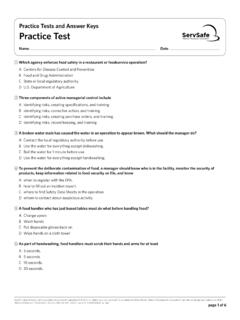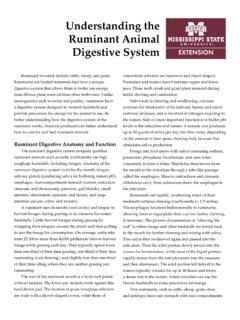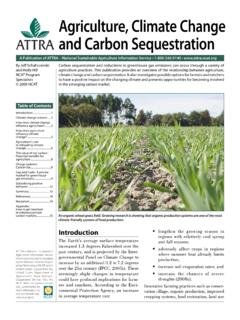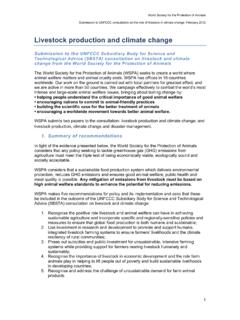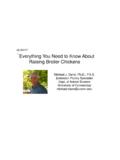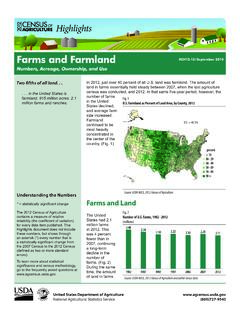Transcription of Ruminant Digestive Anatomy and Function
1 Cattle Business in Mississippi February 2011 Beef Production Strategies article Ruminant Digestive Anatomy and Function Jane Parish Extension Beef Cattle Specialist, Mississippi State University Ruminant livestock include cattle, sheep, and goats. Ruminants have a unique Digestive system that allows them to better utilize energy from fibrous plant material than other herbivores. Unlike monogastrics such as swine and poultry, ruminants have a Digestive system designed to ferment feedstuffs and provide precursors for energy for the animal to utilize.
2 By better understanding how the Digestive system of the Ruminant works, livestock producers can better understand how to care for and feed the Ruminant animal. The Ruminant Digestive system uniquely qualifies Ruminant animals such as cattle to make efficient use of high roughage feedstuffs such as forages. Anatomy of the Ruminant Digestive system includes the mouth, tongue, salivary glands, esophagus, 4-compartment stomach (rumen, reticulum, omasum, and abomasum), pancreas, gall bladder, small intestine, and large intestine. A Ruminant uses its mouth and tongue to harvest forages during grazing or to consume harvested feedstuffs.
3 Cattle harvest forages during grazing by wrapping their tongue around the plants and then pulling to tear the forage for consumption. On average, cattle take from 25,000 to over 40,000 bites to harvest forage while grazing each day. They typically spend over one-third of their time grazing, one-third of their time ruminating (cud chewing), and slightly less than one-third of their time idling where they are neither grazing nor ruminating. The roof of the Ruminant mouth is a hard/soft palate without incisors. The lower jaw incisors work against this hard dental pad.
4 The incisors of grass/roughage selectors are wide with a shovel-shaped crown, whereas those of concentrate selectors are narrower and chisel-shaped. Premolars and molars match between upper and lower jaws. These teeth crush and grind plant material during initial chewing and rumination. Saliva aids in chewing and swallowing, contains enzymes for breakdown of fat and starch, and is involved in nitrogen recycling to the rumen. Saliva s most important Function is to buffer pH levels in the reticulum and rumen. A mature cow produces up to 50 quarts of saliva per day, but this varies depending on the amount of time spent chewing feed, as that stimulates saliva production.
5 forage and feed mixes with saliva containing sodium, potassium, phosphate, bicarbonate, and urea when consumed to form a bolus. That bolus then moves from the mouth to the reticulum through a tube-like passage called the esophagus. Muscle contractions and pressure differences carry these substances down the esophagus to the reticulum. Ruminants eat rapidly, swallowing much of their feedstuffs without chewing them sufficiently (< inches). The esophagus functions bi-directionally in ruminants allowing them to regurgitate their cud for further chewing, if necessary.
6 The process of rumination or chewing the cud is when forage and other feedstuffs are forced back to the mouth for further chewing and mixing with saliva. This cud is then reswallowed and passed into the reticulum. Then the solid portion slowly moves into the rumen for fermentation while most of the liquid portion rapidly moves from the reticulorumen into the omasum and then abomasum. The solid portion left behind in the rumen typically remains for up to 48 hours and forms a dense mat in the rumen where microbes can use the fibrous feedstuffs to make precursors for energy.
7 True ruminants such as cattle have one stomach with four compartments: the rumen, reticulum, omasum, and abomasum. The Ruminant stomach occupies almost 75 percent of the abdominal cavity, filling nearly all of the left side and extending significantly into the right side. The rumen is the largest stomach compartment, holding up to 40 gallons in a mature cow. The reticulum holds approximately 5 gallons in the mature cow. Typically, the rumen and reticulum are considered one organ because they have similar functions and are only separated by a small muscular fold of tissue.
8 They are collectively referred to as the reticulorumen. The omasum and abomasum hold up to 15 and 7 gallons, respectively, in the mature cow. The reticulorumen is home to a population of microorganisms (microbes or rumen bugs ) that include bacteria, protozoa, and fungi. The purpose of these microbes is to ferment and break down plant cell walls into their carbohydrate fractions and produce volatile fatty acids (VFAs) from these carbohydrates. These VFAs are later used by the animal for energy. The reticulum is called the honeycomb because of the honeycomb appearance of its lining.
9 It sits underneath and towards the front of the rumen lying against the diaphragm. Ingesta flow freely between the reticulum and rumen. The main Function of the reticulum is to collect smaller digesta particles and move them into the omasum while the larger particles remain in the rumen for further digestion. The reticulum also traps and collects heavy/dense objects consumed by the animal. When a nail, wire, or other sharp heavy object is consumed by a Ruminant , it is very likely that the object will be caught in the reticulum.
10 During normal Digestive tract contractions this object can penetrate the reticulum wall, and make its way to the heart, where it can lead to hardware disease. The reticulum is sometimes referred to as the hardware stomach . The rumen is sometimes called the paunch . It is lined with papillae for nutrient absorption and divided by muscular pillars into sacs. The rumen acts as a fermentation vat by hosting microbial fermentation. About 50 to 65 percent of starch and soluble sugar consumed is digested in the rumen. Rumen microorganisms (primarily bacteria) digest cellulose from plant cell walls, digest complex starch, synthesize protein from non-protein nitrogen, and synthesize B vitamins and vitamin K.





